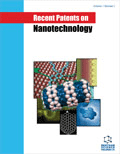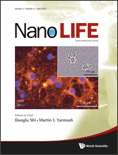
Nanomedicine Journal
Scope & Guideline
Empowering Innovation in Nanomedicine Research.
Introduction
Aims and Scopes
- Nanoparticle Drug Delivery Systems:
Research on the development and optimization of nanoparticles as carriers for drug delivery, targeting specific cells or tissues to improve therapeutic efficacy and minimize side effects. - Biosynthesis and Characterization of Nanomaterials:
Studies focusing on the green synthesis methods of nanoparticles using plant extracts or biological agents, along with their characterization for various biomedical applications. - Nanotechnology in Cancer Therapy:
Exploration of novel nanocarriers and therapies for cancer treatment, including targeted drug delivery systems and theranostic applications that combine diagnostics and therapeutics. - Antimicrobial and Antiviral Applications:
Research on the use of metallic and metal oxide nanoparticles for their antimicrobial properties against various pathogens, including drug-resistant strains. - Nanotechnology in Neurology:
Investigations into the application of nanomaterials for the treatment of neurological disorders, including drug delivery systems designed to cross the blood-brain barrier. - Innovative Diagnostic Methods:
Development of nanotechnology-based diagnostic tools and imaging techniques to improve the detection and monitoring of diseases.
Trending and Emerging
- Green Synthesis of Nanoparticles:
There is a significant increase in studies focused on environmentally friendly methods for synthesizing nanoparticles, highlighting the importance of sustainability in nanomedicine. - Targeted and Personalized Medicine:
A growing emphasis on personalized medicine is evident, with research focusing on developing nanoparticles that can be tailored for specific patient needs and disease characteristics. - Nanomaterials in Immunotherapy:
Recent publications have increasingly explored the role of nanotechnology in enhancing immunotherapy approaches, particularly for cancer treatment, indicating a shift towards integrating nanomedicine with immunology. - Smart Drug Delivery Systems:
The emergence of smart, stimuli-responsive drug delivery systems has gained traction, showcasing innovations that allow for controlled release mechanisms based on external triggers. - Nanotechnology in Regenerative Medicine:
Research exploring the applications of nanotechnology in regenerative medicine, particularly in tissue engineering and stem cell therapy, is on the rise, reflecting a trend towards repairing and regenerating damaged tissues.
Declining or Waning
- Traditional Chemical Synthesis Techniques:
There is a noticeable decrease in publications centered around conventional chemical synthesis methods for nanoparticles, as the field increasingly favors green and biological synthesis approaches. - General Reviews on Nanotechnology:
The frequency of broad review articles covering general aspects of nanotechnology has diminished, with a shift towards more targeted reviews that address specific applications or case studies. - Metal-Based Nanoparticles for Non-Biomedical Applications:
Research focusing on the utilization of metal nanoparticles in non-biomedical fields has become less prominent, as the journal concentrates more on health-related applications. - Older Drug Delivery Systems:
The exploration of established drug delivery systems has waned, with a clear trend towards novel and more sophisticated delivery mechanisms, particularly those involving stimuli-responsive systems.
Similar Journals

Advanced NanoBiomed Research
Pioneering Research in NanobiomedicineAdvanced NanoBiomed Research is a pioneering open-access journal committed to advancing the interdisciplinary field of nanobiotechnology, published by WILEY-V C H VERLAG GMBH. Since its inception in 2021, this journal has provided a platform for innovative research that bridges the gap between engineering, medicine, and materials science. With impressive rankings in Scopus, positioning it within the top quartiles of various categories, Advanced NanoBiomed Research aims to disseminate high-quality research that contributes to the understanding and application of nanomaterials in biomedical contexts. As it encompasses a wide scope—from applied microbiology to biomaterials—it serves as an essential resource for researchers, professionals, and students eager to explore the cutting-edge developments in the field. The journal promotes a collaborative environment where emerging ideas can flourish, ensuring that vital advancements in nanobiomedicine can be shared and built upon within the scientific community.

International Journal of Nanomedicine
Exploring the frontiers of nanotechnology in medicine.International Journal of Nanomedicine, published by DOVE MEDICAL PRESS LTD, is a leading open access journal dedicated to advancing the field of nanomedicine and its applications in healthcare. Since its establishment in 2006, the journal has grown significantly, now encompassing a wide array of topics including bioengineering, biomaterials, biophysics, drug discovery, and pharmaceutical sciences, and is recognized in Q1 quartiles across major categories like *Nanoscience and Nanotechnology* and *Organic Chemistry*. The journal boasts an impressive standing within the Scopus rankings, with high percentiles across various related fields, making it an invaluable resource for researchers, professionals, and students seeking to stay informed on the latest innovations and developments in nanomedicine. With its commitment to fostering an accessible and collaborative academic environment, the International Journal of Nanomedicine serves as a vital platform for disseminating transformative research that impacts scientific practice and healthcare outcomes globally.

Nanofabrication
Fostering Collaboration in the Nanofabrication CommunityNanofabrication is a leading open-access journal dedicated to advancing the field of nanotechnology through innovative research and comprehensive reviews. Published by the Eurasia Academy Publishing Group (EAPG) since 2014, this journal aims to provide a platform for academic discourse, promoting the latest insights and findings in nanofabrication techniques and applications across diverse domains, including materials science, electronics, and drug delivery systems. With a commitment to accessibility, Nanofabrication ensures that all content is freely available to researchers, professionals, and students worldwide, thereby fostering collaboration and knowledge sharing in the rapidly evolving landscape of nanotechnology. The journal's emphasis on high-quality, peer-reviewed research positions it as an authoritative source for those looking to stay at the forefront of developments in the field.

Journal of Nano Research
Transforming Ideas into Nano InnovationsThe Journal of Nano Research, published by Trans Tech Publications Ltd, is a distinguished academic journal dedicated to the rapidly evolving field of nanotechnology and materials science. With an ISSN of 1662-5250 and an E-ISSN of 1661-9897, the journal has been an important platform for researchers and professionals since its inception in 2008, continuing to provide high-quality peer-reviewed research through to 2024. Nestled in Switzerland, the Journal of Nano Research plays a pivotal role in disseminating cutting-edge findings, as recognized by its categorization in Q3 for Materials Science and Physics while being positioned in Q4 for Nanoscience and Nanotechnology as of 2023. With Scopus rankings highlighting its impact, including Rank #129 in general Physics and Astronomy and Rank #300 in Materials Science, this journal is crucial for academics seeking to stay ahead in research trends and innovations in nano-related disciplines. Although it operates under a subscription model, the journal's objectives include fostering collaboration and knowledge-sharing among researchers, making it an invaluable resource for anyone immersed in the world of nanotechnology.

Recent Patents on Nanotechnology
Exploring Breakthrough Patents Shaping NanoscienceRecent Patents on Nanotechnology, published by Bentham Science Publishers Ltd and based in the United Arab Emirates, is a vital resource for researchers and professionals in the rapidly evolving field of nanotechnology. Spanning from 2007 to 2024, this journal serves as a comprehensive platform for scholarly articles discussing innovative patents that drive advancements within various sub-disciplines including condensed matter physics, engineering, and materials science. With notable rankings in the Q3 and Q2 quartiles, it maintains a respectable position in key Scopus categories, highlighting its relevance and impact within the academic community. Although not open access, the journal is committed to facilitating the dissemination of cutting-edge findings and fostering collaboration among nanotechnology experts. As the field continues to expand, Recent Patents on Nanotechnology stands as an essential reference for anyone aiming to navigate the complexities and promise of nanotechnological innovations.

ACS Biomaterials Science & Engineering
Pioneering Transformative Solutions in Biomedical EngineeringACS Biomaterials Science & Engineering, published by the American Chemical Society, serves as a premier platform for the latest advancements and research in the fields of biomaterials and biomedical engineering. With an impressive impact factor and a strong reputation reflected in its ranking—Q2 in Biomaterials and Q1 in Biomedical Engineering—the journal attracts a diverse and engaged readership. Since its inception in 2015, it has aimed to foster innovation by publishing high-quality research articles, reviews, and perspectives on the synthesis, characterization, and application of biomaterials. Researchers and professionals benefit from the journal's rigorous peer-review process and its focus on translational science, making it essential for those looking to stay at the forefront of biomaterials research. Located in Washington, DC, USA, the journal plays a pivotal role in connecting academic and industrial sectors, ultimately driving advancements that impact biomedicine and related fields.

International Journal of Nano Dimension
Unveiling the potential of nanomaterials in science and engineering.The International Journal of Nano Dimension is a premier publication dedicated to advancing the field of nanotechnology and its applications across various disciplines, published by the Islamic Azad University, Tonekabon Branch. With an ISSN of 2008-8868 and an E-ISSN of 2228-5059, this journal serves as a vital platform for researchers, professionals, and students seeking to disseminate and access cutting-edge findings in nano materials and their integration into science and engineering. The journal has gained notable recognition in Scopus rankings, especially within the fields of Materials Science and Chemical Engineering, emphasizing its commitment to high-quality research. Spanning the years from 2019 to 2024, the journal emphasizes open access to foster knowledge sharing in the scientific community. As nanotechnology continues to revolutionize industries, the International Journal of Nano Dimension plays an essential role in showcasing transformative research that addresses the challenges and opportunities of this dynamic field.

Nano LIFE
Exploring the intersection of nano and life sciences.Nano LIFE, published by World Scientific Publishing Company, is a multidisciplinary journal that delves into the dynamic fields of bioengineering, biomedical engineering, and pharmaceutical science, providing a platform for researchers to disseminate their cutting-edge findings. With an ISSN of 1793-9844 and e-ISSN 1793-9852, this journal emphasizes the significance of nanoscale research in healthcare and technology, positioning itself as a vital resource for professionals and academics alike. Although currently categorized in the Q4 quartile for multiple scientific disciplines in 2023, its unique focus on the intersection of nanotechnology and life sciences aims to elevate the discourse in these rapidly evolving sectors. Researchers can anticipate publishing innovative methodologies and results, contributing to the overall understanding and application of nanotechnology in medicine. Located in Singapore, Nano LIFE not only serves the global research community but also reflects the growing interest in nanotechnology across diverse fields.

International Journal of Pharmaceutics-X
Exploring novel applications in the realm of pharmaceutics.International Journal of Pharmaceutics-X is a premier open access journal published by Elsevier, dedicated to advancing knowledge and research in the field of pharmaceutical sciences. Launched in 2019, this journal has quickly ascended to the Q1 category in the 2023 Category Quartiles, reflecting its high impact and the quality of research it promotes. With a current Scopus ranking of #49 out of 183 in the Pharmacology, Toxicology and Pharmaceutics category, this journal occupies the 73rd percentile, showcasing its significant influence within the scholarly community. Emphasizing innovative research and novel applications, the International Journal of Pharmaceutics-X offers a platform for researchers, professionals, and students to disseminate their findings, making crucial contributions to the global pharmaceutical landscape. The journal is based in the Netherlands, presenting a vibrant hub for scientific discourse and collaboration in a rapidly evolving field.

IEEE Open Journal of Nanotechnology
Pioneering Research in Nanotechnology ApplicationsIEEE Open Journal of Nanotechnology is an innovative publication dedicated to advancing the field of nanotechnology, with a particular focus on its applications in areas such as computer science, electrical engineering, and materials science. As an esteemed publication of the IEEE (Institute of Electrical and Electronics Engineers), established since 2020, it follows a robust Open Access model, ensuring that high-quality research is accessible to a global audience without financial barriers. This journal is notable for its diverse scope and has rapidly gained recognition, achieving a commendable Q3 ranking across multiple categories, including Computer Science Applications and Materials Chemistry, according to the latest 2023 assessments. With a Scopus ranking that places it among the top journals in the engineering and materials science domains, the IEEE Open Journal of Nanotechnology is positioned as a critical resource for researchers, professionals, and students interested in the cutting-edge developments and methodologies in nanotechnology. The journal promotes interaction and collaboration among scholars and practitioners, making it a vital platform for sharing novel insights and innovations in this rapidly evolving field.